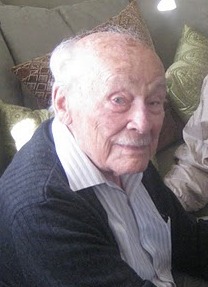Physicist
Interests: Quantum Theory Age: 105
Evert Jan Post, of Los Angeles, who likes to call himself an "establishment physicist," nevertheless has been publishing very important and incisive criticisms of contemporary orthodoxy for over 30 years. Many consider his 1967 article "Sagnac Effect" (Rev. of Mod. Physics, V39, N2, pp. 475-493, Apr 1967) the most important explication ever made of this major phenomenon, crucial to many alternative theories and a never-ending source of embarrassment to orthodox theoreticians. He has also made important attempts to improve on standard quantum physics, such as in his Quantum Reprogramming, Kluwer, 1995.
Dr. Post first worked in Holland with interests in crystallography as applied to electromagnetic circuits. After working in industry for some time, he obtained his Ph.D. degree and worked with the Schouten school and the Kramer's school in Holland. In 2000 he will be 86, and yet is still very active in the field of Physics. During his life he has had many "chats" (as he calls them) with many of the great leaders of physics in the formative years of the quantum theory. His first hand stories were always intriguing to me, when we went out for a simple dinner of soup and salad at Alfred's restaurant in Houston.
His article on the Sagnac effect (Rev of Mod Physics) is what attracted me to Jan's work. Later I discovered his monograph "The Formal Structure of Electromagnetics" in which I saw the first definitive treatment of the Faraday effect, and its non-reciprocity. This idea was what I had been searching for, for if an experiment between EM and gravity was to work, it would have to accumulate data - like the Faraday ratchet - in order to measure very small effects.
The Jacksonian version of EM theory did not come close to explaining the features that were so clear in Post's expose. I used to call the small book, the "Tourist's Guide of Electromagnetism". The book is back in print now (Dover), and no one interested in EM should be without it.
After reading the Sagnac article I called Post (in Massachusetts at the time) and in a few weeks he showed up at my door in Houston, and stayed for several years. He taught me tensors, and I introduced him to differential forms a la Cartan. Over the years we have had many interesting interactions, and when I discovered the 3-form A^G of electromagnetic spin (1974) I know that he finally believed in the Cartan topological formulation of Electro-magnetism.
Dr. Post went on to use the de Rham theory to predict in 1980 the rational fraction Hall effect, and yet his publications - two years before the experiments - are never referenced, for he was not, and never will be, a member of the "everything must be quantum mechanics according to Copenhagen" clique that so dominates much of modern physics thinking. He keeps publishing several articles a year about the foundations of QM and applications of the topological view of Physics. One of his latest works is on Quantum Reprogramming from Kluwer. - Robert Kiehn
Articles:
- "Sagnac Effect," Reviews of Modern Physics 39 (2): 475-493 (Apr 1967). A revived interest in the Sagnac effect has recently resulted from the development of the self-oscillating laser version of the original Sagnac interferometer. The Sagnac interferometer or ring laser is an example of an electromagnetic sensor of absolute rotation, so historical and theoretical background information is useful in evaluating the possibilities of electromagnetic sensing of absolute rotation. A critical literature study of the many experimental ramifications and the older kinematical theory of the effect is presented. This geometric optical theory is then complemented and compared with more recent work that is based on a physical optical analysis using a complete electromagnetic description of the phenomenon.
- "The Constitutive Map and Some of its Ramifications?, Annals of Physics 71 (2): 497-518 (Jun 1972). The constitutive map is introduced to replace the familiar relation Image and Image . Its objective is a rigorous functional separation between field- and constitutive equations. The possibility to implement this functional separation is shown to depend critically on the introduction of electric charge as an independent space-time invariant unit, rather than as a unit derived from mass, length, and time. The linear map is shown to be invariant under the conformal group, while the field equations remain invariant under general space-time diffeomorphisms. Algebraic and differential comitants of the linear map are discussed, their physical roles are identified. The impedance of a medium emerges as a space-time invariant. The new concepts are then applied to prove the invariance and constancy of the fine structure ?constant? and the ratio e2/planck constant over two pi.
- "Can Microphysical Structure Be Probed by Period Integrals?" Physical Review D 25 (12): 3223-3229 (Jun 1982). The following is an exploratory investigation into the viability of using period laws in questions pertaining to particle topology. Since the macro-micro distinction in physics is a metric-related notion, metric independence is taken to be the key to whether or not such laws can be extrapolated into the microphysical realm. The topology of microphysical structures can then be tested on their one-, two-, and three-connectedness with the help of three period laws. The partly qualitative topological information obtained by these metric-free criteria is then resubmitted to a process of metric adaptation for further quantitative answers.
- "On the Quantization of the Hall Impedance", Physics Letters A 94 (8): 343-345 (Mar 1983). The quantized Hall impedance is shown to relate to the ratio of two period integrals which are identified as the familiar period integrals of flux and electric charge if their domain of definition is extended to the realm of spacetime.
- "Quantum Hall Effect as Experimentum Crucis", Physics Letters A 125 (5): 225-227 (Nov 1987). The issue of Copenhagen versus statistical ensemble interpretation is identified as a possible key to a coherent and joint single system description of the integer and fractional quantum Hall effects.


